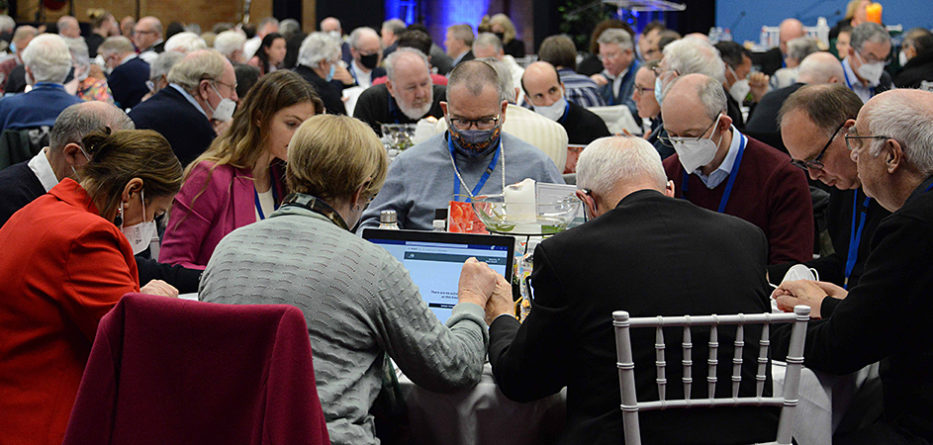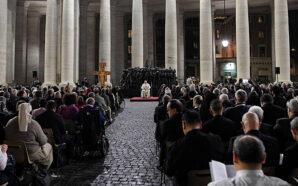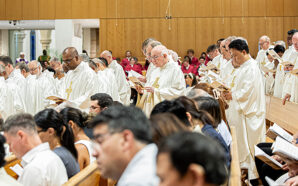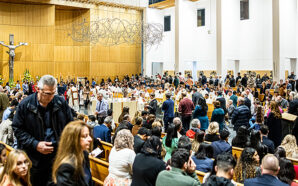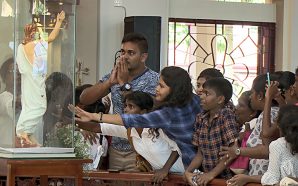The Plenary Council is likely to go down in the history of the Church in Australia as a moment when it entered a new era.
The Church in Australia has entered a new era. It is learning how to be a synodal Church – and its experience is offering valuable lessons to global Catholicism
After four years of listening sessions, hundreds of thousands of submissions, two major assemblies, dozens of motions, amendments and votes, and one near walk-out, Australia’s fifth plenary council ended on 9 July with an intense, rollercoaster final gathering in Sydney. The council is likely to go down in the history of the Church in Australia as a moment when it entered a new era. It has shown that, however messy things get, bishops, priests, Religious and lay people can listen to each other and take joint responsibility for the Church’s mission. Australia’s Catholics have shown the global Church that, though it ain’t always easy, synodality works.
The assembly in Sydney itself symbolised the flatter, more participatory Church of the Francis era rather than the vertical, bishops-know-best top-down model of previous pontificates. The discussions took place at round tables, with lay people, priests and bishops evenly distributed. This reflected one of the transformative images in the Second Vatican Council’s constitution, Lumen Gentium, which defines the Church first of all as the community of the baptised, a “People of God”; only then did it talk of the hierarchy. “The Church may not be a democracy, but it’s not a monarchy, oligarchy or autocracy. It’s the community of faith emboldened by the Spirit,” is how Ormond Rush, an adviser to the plenary and one of the most respected interpreters of Vatican II, put it to me.
While there was tension and sometimes passionate disagreements between the members of the council – which cut across laypeople and clergy and across different issues – the differences did not lead to deeply entrenched, polarising divisions. To widespread surprise and relief, a two-thirds consensus was reached on a range of motions. Ten decrees agreed by the assembly included: apologising for the harm done by the Church to victims and survivors of abuse and to marginalised groups such as indigenous people and LGBTQ Catholics; a call for a greater role for lay people in governance; and recognising the sacred duty to protect the environment. Some motions, such as a call to change canon law to allow lay people to preach during Mass, failed to get a two-thirds majority.
Two motions were agreed that make it clear that the Church in Australia is entering a new era. One was a call for a new English translation of the Roman Missal to replace the controversial version introduced in 2011. This motion unexpectedly emerged from the floor during discussions on the liturgy. Significantly, it was voted through overwhelmingly by the “deliberative voters” (the bishops) as well as by the “consultative voters” (the bulk of participants). The second was a vote requesting that Pope Francis allow greater use of the “Third Rite” of Confession, known as “general absolution”, which had been widely used in Australia until Rome intervened to stop the practice following a summit meeting between Australian bishops and the heads of several departments of the Curia in 1998. This had a profound impact. The use of the “Third Rite”, a way of offering people the Sacrament of Reconciliation after a communal celebration in circumstances where there is a shortage of priests, was also a reason why the Holy See removed the former Bishop of Toowoomba, Bill Morris, from office.
Archbishop Mark Coleridge, looking relieved and elated at the end of a tough week, told me he saw the action of the Holy Spirit throughout the assembly. The archbishop, who stepped down as President of the Australian Bishops’ Conference this month, said he was surprised and happy that the motion on the liturgy had passed, even though he had been involved in the 2011 translation. “I think the translations we are currently working with are patently not serving the needs of the Church, even though they have some strengths,” he said.
The decisions on liturgy and on the Sacrament of Reconciliation chart a very different course to that insisted on by Cardinal George Pell, the former Archbishop of Melbourne and then of Sydney, and the most influential churchman in Australia from the late-1990s until he moved to Rome to be the inaugural prefect of the Secretariat for the Economy in 2014.
As president of the Vatican’s “Vox Clara” commission, Pell was the driving force behind the current translation of the Roman Missal. He also adopted a strong stance against the use of general absolution.
The decisions taken by the council will take time to implement, and are likely to come up against various hurdles. But what is clearly emerging is a Church in Australia no longer working under the terms of the Pell vision. For 25 years, he was the public face of the Church in Australian society, the policy maker who also held enormous sway over the appointments of bishops. Pell embodied a combative Church, outspoken in its opposition to the legalisation of abortion and same-sex civil unions. In Rome, his single-minded, forceful approach was to serve him well when he sought to crack down on Vatican financial corruption, but his defence of a particular version of Catholic orthodoxy had allowed for little internal dissent.
There is often a tension in the synodal process between the desire to allow time for discernment and spiritual conversion and the less patient impulse to get decisions made and plans agreed. In the plenary council, there was always a temptation to follow a more or less undisguised political approach, manoeuvring as necessary to get motions passed or blocked. All this required careful navigation. Archbishop Tim Costelloe, President of the Council, opened the batting by urging members to collectively listen to the Holy Spirit, reminding them that this was not a gathering of “combatants” seeking to prevail over one another. When he became ill, Archbishop Coleridge took to the crease. When a crisis arose over a failure to get agreement on the role of women, he managed to settle nerves with some quick boundaries. Bishop Shane Mackinlay, vice-president of the council, then came in to bat. Facing an intense bowling attack, over several days he demonstrated an instinct for knowing which balls to leave and which to strike.
Sources inside the assembly hall believed a group coalescing around the Sydney archdiocese were working to block certain motions. They had some formidable fast bowlers and this was a home fixture. Sydney’s in-house media outlet, The Catholic Weekly, which was distributed among members, ran consistently critical and, at times, deeply hostile coverage of the council. This coverage continues. “It felt like this was the Sydney archdiocese against the rest of the Church in Australia,” is how one observer put it.
The blocking of some motions took place despite them having emerged out of four years of dialogue and listening, involving 222,000 Catholics across the country. A plenary council process is the highest form of local gathering for a local Church, and is the first one to take place in Australia since 1937. During the discussion phase, the role of women in the Church consistently came up, and this was the first plenary council with women members. Speaking during the assembly, Virginia Bourke, the chair of Mercy Health Australia, a large healthcare provider founded by the Sisters of Mercy, talked of the disconnect between the roles held by women in civic and community life and those held in the Church. It was, she argued, why many women – and men – were walking away.
It was this issue which led to a crisis, when a vote on a motion included in the decree “witnessing to the equal dignity of men and women” failed to get enough votes. The motion called for women to have greater roles in decision making and governance, and welcomed the possibility of female deacons. While the members voted in favour, the bishops did not give it a two-thirds majority. The failure to pass the motion caused deep upset, as it meant the plenary would have nothing to say about the role of women. Some members were in tears. “I was completely crushed,” Maddy Forde, 26, who works in campus ministry at the Australian Catholic University, told me. The high emotions led to dozens of members, including some bishops, refusing to take their seats for the next session.
Crisis talks took place, and the motions were re-drafted and put to another vote, which passed. They included a motion on women deacons; Australia, after the Amazon, became the second local Church to say it would welcome this development. It was an example of overcoming clericalism – that disconnect between the leadership of the Church and those they are called to serve.
“The real disaster would have been had we simply used strong-arm tactics, ignored the distress, and stuck to our plans and strategies; that would have led to a complete unravelling of the assembly,” Archbishop Coleridge told me. In the end, the crisis became the turning point. It was a death and resurrection moment. Despite the rollercoaster, the archbishop believes that the Holy Spirit has been in charge of the process from the very start, even though some have often told him this idea is “bunkum”. On the synodal reforms, he stresses: “There’s no other way into the future.”
The tensions in Australia’s plenary council are a microcosm of the wider battles within the Church. If Australia is anything to go by, the synod summit in 2023 in the Vatican is going to be a dramatic time, and any moves to reform the Church will face well-organised resistance. Among those observing the proceedings in Sydney was the papal ambassador to Australia, the Brooklyn-born Archbishop Charles Balvo, a warm and engaging figure who mingled freely with members. His presence was a reminder that the final resolutions of the assembly will need to be signed off by the Pope. Cardinal Charles Bo, President of the Federation of Asian Bishops’ Conferences, and New Zealand’s Cardinal, John Dew, were also present as observers, which indicated the global significance of the council.
The dividing line over synodality often appears to be less about theological differences and more about different mentalities. “The division is between people who feel that the only way forward is the way they know and people who think there might be a number of ways forward,” Cathy Jenkins, a member of the plenary who has worked as director of evangelisation for the Archdiocese of Melbourne, told me.
The Australian Church is far from monochrome. One of the most formidable intellects inside the hierarchy is the Archbishop of Sydney, Anthony Fisher, a Dominican who studied for his doctorate in bioethics in Oxford in the 1990s. He had recently returned to Australia after giving a talk to the United States’ bishops on the topic of synodality and collegiality. His invitation to address what is a notoriously divided US hierarchy suggests that he is considered able to appeal to those sceptical of the Francis pontificate while avoiding incendiary rhetoric. Although it is no secret that Archbishop Fisher has been mentored by Cardinal Pell, the two are very different in style.
A former commercial lawyer, Archbishop Fisher is remarkably fluent and is someone you would want on your legal team rather than working for the other side. Despite having some anxieties, he told me he thought the plenary process had “ultimately worked but it was messy.” He added: “Some would say this is the evidence of the action of the Holy Spirit, some would say it is the evidence of just the sheer good will of the people who were there. One way or another, even with an imperfect process, we ultimately got to a result that people were in a high level of agreement with.”
Speaking to me in his residence opposite St Mary’s Cathedral, he identified some “gaps” in the process. More emphasis, he said, should have been placed on evangelisation in light of recent census figures which show 40 per cent of Australians do not believe in God. The focus on women in governance meant “laymen” were invisible and he would also have liked to have seen more said about the unborn, refugees, the trafficked and those with mental health issues. It was a “bit surprising” that threats to religious freedom in Australia had not been on the agenda.
At its heart, Fisher sees the synod process as a way of “leaning into the world”, and becoming, as Francis has called for, a more missionary-focussed Church. He had told the US bishops that being synodal is a “sensibility”, requiring listening to different voices, discerning together and being open to surprises. Some of the talk about synodality is “still a bit vague” and there is a risk that people think by putting the “word ‘synodal’ in front [of something]…it will make it better, kind of holier, churchier or more Roman. ‘I have very synodal shoes on today’ – it’s nonsense.”
I wondered how far the archbishop believes the synodal process can bring about significant internal reform, given that the Australian synodal process, like the German, came about as a response to the sexual abuse of minors by priests and the scandal of how it was handled by the Church. “We certainly have to go in the direction of examining anything structural, cultural, that has helped feed, camouflage, excuse some of this [abuse],” Fisher says. “But I am wary of going too far into that as the explanation of everything also, because if you just pin it all on structures and cultures you can fail to examine [what] actually [happened] – you’ve got to look at the particular people who work for us.”
The critical question now is the implementation of the plenary decrees. Local diocesan synods are likely to be held across Australia to work out how the decrees will take shape. Archbishop Costelloe, the incoming President of the bishops’ conference, told me that the plenary council already shows there’s been a change in the “way we go about looking at the challenges the Church faces”. This in itself is significant as part of a deeper cultural change and ecclesial reform. “We are learning – I think haltingly – how to be a synodal Church,” he added.
The Australian synodal process has shown that, although it is sometimes a rollercoaster ride, trust in the Holy Spirit will open new paths for the Church of the third millennium. It shows that, with goodwill and good leadership, finding consensus amid disagreement is possible. “Everyone has a responsibility to say what they think,” Bishop Greg Homeming, the Australian Chinese leader of Lismore diocese and a Carmelite, said. “But as soon as they say it, they must let go of it in case it is not what God thinks.” The rollercoaster continues.
This article was originally written by Christopher Lamb and published on The Tablet on 19 July 2022. Reproduced with permission.




